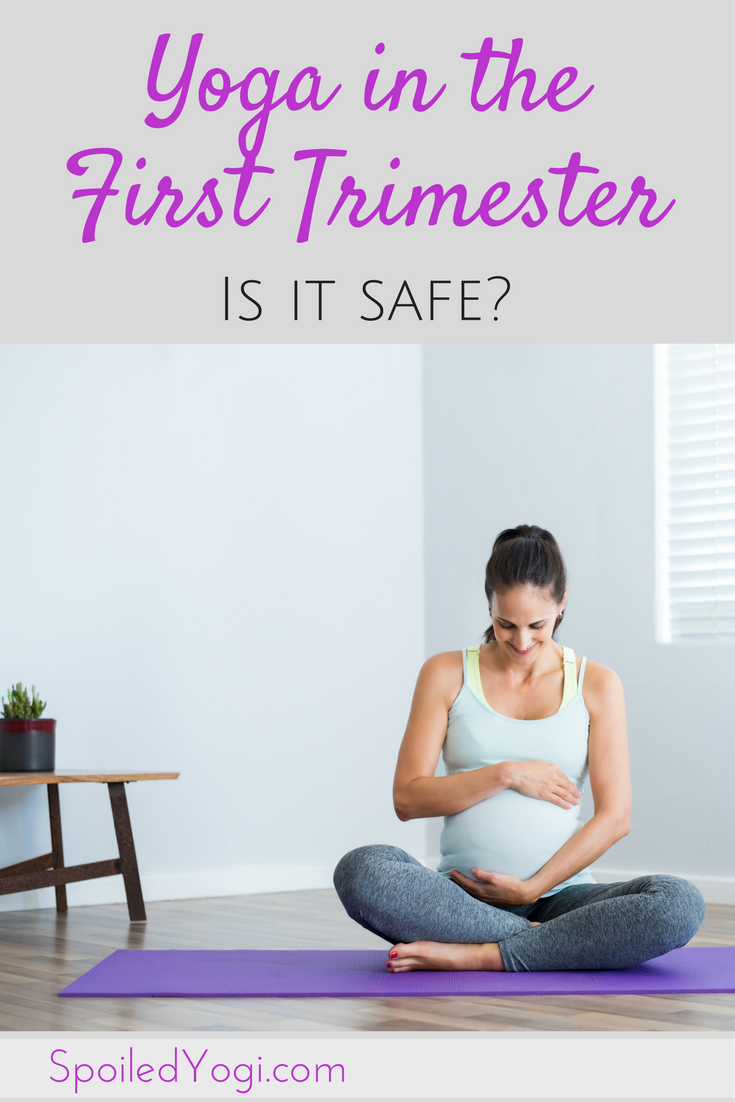
We know that prenatal yoga is great for keeping common pregnancy aches and pain at bay and preparing mama’s body for birth. But there’s a lot of confusion about the safety of yoga in the first trimester. In fact, one of the most common questions new mamas-to-be ask me is if it’s safe to do yoga during those first fragile 13 weeks of a pregnancy.
Are you a newly pregnant mama with an established yoga practice? Or, perhaps, considering to join a class for the first time? Here’s what you need to know.
See also Best Yoga Poses for the First Trimester
Why Is Yoga In the First Trimester Controversial?
Trigger alert: You might have heard that pregnant mamas should wait until the second trimester to practice yoga. That’s because the risk of miscarriage dramatically decreases in the second trimester. In fact, some yoga studios have a policy that says prenatal yoga classes are appropriate for the second and third trimesters.
On the other hand, other yoga teachers and/or studios encourage women to keep up their yoga practice throughout their pregnancies.
What gives? And who is right?
There’s enough to worry about when you’re newly pregnant. Do we really have to add this to the list? I felt the same way during my two pregnancies, so I started doing some research. Here’s some helpful info I found from a couple of my favorite pregnancy yoga books, which talks about how two of the most popular schools of yoga approach yoga in the first trimester:
Iyengar Yoga In the First Trimester
From Yoga a Gem for Women by Geeta Iyengar:
“There are chances of miscarriage during this period due to improper formation of the placenta, prolapse, or muscular weakness of the uterus. It is dangerous during this period to lift heavy loads and to jump about. Yogasanas, however, are non-violent; they strengthen the pelvic muscles and improve blood circulation in the pelvic region; they strengthen the reproductive system, exercise the spine, and make the period of confinement bearable…
“In the early stages of pregnancy morning sickness, dullness, and weakness may appear. Sometimes there are discharges or pains in the pelvic region, swelling or numbness in the feet, swollen veins and varicose veins, backache, constipation, variation in blood pressure, toxaemia, headache, dizziness, blurred vision, and infrequent urination. In all these conditions asanas are most helpful.”
Ashtanga Yoga In the First Trimester
From Yoga Sadhana for Mothers: Shared Experiences of Ashtanga Yoga, Pregnancy, Birth & Motherhood by Sharmila Desai and Anna Wise:
“Practicing yoga during the first trimester is not recommended, and women are encouraged to avoid taking unnecessary risks during this important time.
“Obviously, making the choice to continue practicing during the first 13 weeks of pregnancy is a personal one…
“The first trimester is the time of greatest physical adaptation, and women may experience nausea, fatigue, low blood pressure, constipation, headaches, shortness of breath, and mood swings. The risk of miscarriage is high, especially at the point when a woman would normally menstruate, sometime around week 8 and again at week 12/13, when placenta should take over hormone production.”
Who’s Right?
Who should you listen to? Me! (I’m kidding! Sort of.)
Seriously, though, let’s unpack this a bit. If you think about these styles of yoga it gives you a big clue as to what you should be doing in those first weeks of pregnancy.
Ashtanga Yoga is an intensely physical practice. Serious practitioners are called to practice two hours every morning with few exceptions. The Primary Series includes jumping, jumping through, intense core work… And that’s just the first series. It’s designed to push the practitioner both physically and mentally.
Iyengar Yoga, on the other hand, is all about the alignment. It focuses on all the tiniest little details of every pose, using props when necessary to achieve that alignment. In many ways Iyengar Yoga is more grueling than any other type of practice. (It takes some major mental discipline to spend so much time and energy on the teeny tiny details.) However, it tends to be much slower paced than Ashtanga-based practices (that includes vinyasa yoga styles). That means that in a group class there’s a lot more time for making individual adjustments, using props, etc.
Is It Safe to Do Yoga In the First Trimester?
With that understanding, the safety of practicing yoga in the first trimester really depends on what you’re used to and how you’re feeling. If you’re used to a very strong practice, like Ashtanga or vinyasa, it’s probably OK to keep doing your practice with some modifications. Go easy on the deep twists and backbends. Listen to your body and rest when you feel tired. But if you’re feeling strong and energetic there’s no reason to sideline yourself for three months.
If you’re new to the practice of yoga, you’ll probably want to start with something a little gentler. Sign up for a prenatal yoga class or, if you’re feeling particularly fatigued, find an amazing Restorative Yoga class. Find a teacher who has some training in prenatal yoga. (If you’re not sure, ask!) And be sure you share your news with the teacher (even if you’re not sharing your news with the world yet!).
The Bottom Line
The threat of miscarriage is SO scary. I know. I had a miscarriage between my two healthy girls. When I was pregnant with our rainbow baby my anxiety was epic. I learned that the vast majority of miscarriages are caused my a problem with the baby’s DNA, and there’s not a damn thing you can do about that. If it’s going to happen, it’s going to happen. It’s very unlikely (if it’s possible at all) to cause a miscarriage by doing a deep twist or jumping from Downward Dog to Uttanasana.
See also A Meditation for Anxiety During Pregnancy and Beyond
I didn’t let my anxiety cause me to stop doing my practice during my pregnancy because it was my practice that grounded me. I knew I couldn’t control the outcome of the pregnancy. I recognized that the only thing I had control over was keeping my vibration high and my stress levels low. A gentle yoga practice, meditation, pranayama, and lots of positive affirmations helped me do that. It can do it for you, too.
My advice as a prenatal yoga teacher and mom of two? Be cautious, sweet mama. Listen to your body’s whisperings. But don’t give up your practice.
Congratulations!



Comments